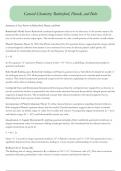General Chemistry: Rutherford, Planck, and Bohr
Summary of Key Points on Rutherford, Planck, and Bohr
Rutherford’s Model Ernest Rutherford conducted experiments that led to the discovery of the atomic nucleus. He
proposed that atoms have a dense, positively charged nucleus which contains most of the atom’s mass, while the
rest of the atom is mostly empty space. This model accounts for only a small portion of the atom’s overall volume.
Planck’s Quantum Theory In 1900, Max Planck introduced the first quantum theory, suggesting that energy emitted
as electromagnetic radiation from matter is not continuous but comes in discrete packets called quanta. He
formulated the relationship between energy (E) and frequency (f) through his equation:
E = hf
In this equation, “h” represents Planck’s constant (6.626 × 10^-34 J·s), establishing a fundamental principle in
quantum mechanics.
Bohr Model Building upon Rutherford’s findings and Planck’s quantum theory, Niels Bohr developed his model of
the hydrogen atom in 1913. Bohr proposed that an electron orbits a central proton in a circular path around the
nucleus. This model incorporated quantized energy levels for electrons, explaining how electrons can occupy
specific orbits without radiating energy.
Centripetal Force and Electrostatic Interaction Bohr proposed that the centripetal force required for an electron to
revolve around the nucleus is generated by the electrostatic attraction between the positively charged proton and the
negatively charged electron. This foundational concept links classical mechanics with electromagnetic theory,
illustrating how forces govern atomic structure.
Incorporation of Planck’s Quantum Theory To refine classical physics assumptions regarding electron behavior,
Bohr integrated Planck’s quantum theory into his model. Classical mechanics suggests that an object in circular
motion can have an infinite range of values for its radius and velocity. Consequently, angular momentum (L = mvr)
and kinetic energy (K = -107) could theoretically assume any value.
Quantization of Angular Momentum By applying quantum principles, Bohr established quantized restrictions on
angular momentum values for electrons orbiting a hydrogen nucleus. He formulated that the allowed values for
angular momentum are given by:
L = nh / 2π
where “n” is a positive integer (quantum number), “h” is Planck’s constant, and “π“ is Pi. This quantization was a
significant departure from classical mechanics, leading to a more accurate understanding of atomic structure.
Rydberg Unit of Energy (Ry)
The Rydberg unit of energy, denoted as Ry, is defined as 2.18 × 10^-18 electron volts (eV). This unit is crucial in
quantum mechanics, particularly in the context of atomic structure and electron behavior.
, Discrete Energy Changes
Similar to angular momentum, the energy levels of an electron within an atom are quantized. This means that
electrons can only occupy specific energy states corresponding to integer values of the quantum number (n). Each
quantized state represents a distinct energy level.
Zero Energy Reference Point
In this framework, a reference point is established where zero energy corresponds to a state where the proton and
electron are infinitely separated. In this scenario, there is no attractive force acting between them. As electrons
occupy quantized states closer to the nucleus, they experience an attractive force towards the proton, which is
mathematically represented by negative energy values.
Energy Behavior with Respect to Quantum Number n
As an electron moves to higher quantum states (increasing n), its energy becomes less negative. This indicates that
while the absolute value of the energy decreases (the magnitude of negativity diminishes), the actual numerical value
increases. Thus, although the fraction representing energy becomes smaller in magnitude as n increases, it signifies a
rise in energy relative to the zero-energy reference.
In summary, as electrons transition to higher energy levels further from the nucleus, their energies become less
negative and increase numerically despite being lower in magnitude compared to their previous states.
Concept of Quantized Energy
Quantized energy can be understood through the analogy of climbing a staircase. When ascending or descending
stairs, you experience discrete changes in gravitational potential energy, as opposed to a ramp where energy changes
can occur continuously. This means that just like the steps on a staircase allow only specific heights to be reached,
quantized energy allows only certain discrete levels of energy to exist.
Bohr’s Model of the Hydrogen Atom
Niels Bohr proposed a model for the hydrogen atom consisting of a nucleus with one proton at its core, around
which a single electron orbits in defined paths known as orbits. Each orbit corresponds to a specific energy level.
The electron can transition between these orbits by absorbing or emitting energy equal to the difference between
two energy levels. The lowest orbit, which has the smallest radius and represents the lowest energy state, is referred
to as the ground state (n = 1). As you move to higher orbits, both the radius and energy increase.
The key takeaway from this model is that electrons do not occupy arbitrary positions but rather exist in quantized
states defined by their respective energies.
Ground State of an Atom The ground state of an atom is defined as the state with the lowest energy, where all
electrons occupy the lowest possible orbitals. This configuration minimizes the energy of the atom.
Excited State of an Atom An atom enters an excited state when at least one electron is promoted to a subshell that
has a higher energy level than its normal configuration. In Bohr’s model, this promotion corresponds to moving an
electron to an orbit with a larger radius, which signifies higher energy.
Bohr’s Model Niels Bohr developed a model for the hydrogen atom that likens electron orbits to planets orbiting
the sun. In this analogy, each electron travels in circular pathways at specific distances from the nucleus,
corresponding to distinct energy levels. Although Bohr’s model was groundbreaking and earned him a Nobel Prize,
it has been subject to reevaluation over subsequent decades.




